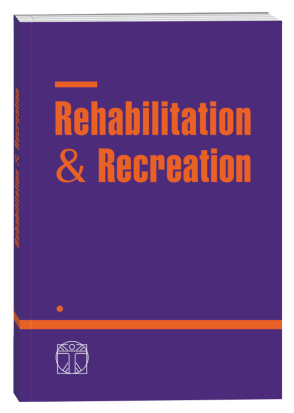THE INFLUENCE OF BODY WEIGHT AND PHYSICAL ACTIVITY ON THE EATING BEHAVIOR OF 12–13-YEAR-OLD GIRLS
DOI:
https://doi.org/10.32782/2522-1795.2023.15.31Keywords:
physical activity, adolescents, body weight, eating behavior.Abstract
The aim of the study was to assess the influence of body weight and indicators of physical activity on the eating behavior of 12–13-year-old girls. Methods included theoretical analysis of special literature on the studied problem, anthropometric measurements (body weight and height, body mass index), Eating Attitudes Test (EAT-26), physical activity assessment methods (Framingham method), and methods of mathematical statistics (descriptive statistics, correlation analysis). Results of the study. The pedagogical study revealed a moderate probability of eating disorders in 12–13-year-old girls with insufficient body weight. The eating habits, lifestyle, and level of physical activity were evaluated based on the information obtained from the surveyed teenage girls (108 girls aged 12 and 30 girls aged 13). A comparison of the eating habits of adolescent girls with normal body weight and underweight girls showed the differences between these two groups. Furthermore, the difference was 17.5 points between 12-year-old girls with different body weights and 20 points between 13-year-old girls of these two groups. The underweight girls aged 12 were found to have the probability of eating disorders of 25.9%. An increase in the probability of eating disorders with age was observed. Eating disorders were observed in 40% of 13-year-old underweight girls. The results of the study demonstrated the presence of a strong direct statistically significant (p < 0.05) influence of body weight and indicators of physical activity on the eating behavior of adolescent girls. The close relationship identified between body weight and indicators of physical activity on the one hand and eating behavior on the other justified the development of physical activity programs for 12–13-year-old girls with a focus on the improvement of the perception of the own body and increasing their involvement in regular physical exercises.
References
Бойко Є.В., Лапіна М.Д. Профілактика розладів харчової поведінки як напрям соціальної роботи. The 7th International scientific and practical conference «The world of science and innovation» (February 10-12, 2021) Cognum Publishing House, London, United Kingdom. 2021. P.343-348
Кульчицька А.В., Федотова Т.В. Соціально-психологічні аспекти формування харчової поведінки в підлітковому віці. Психологічні перспективи. 2019. №33. С. 178-191
Максименко А., Андрєєва О., Хрипко І. Порівняльний аналіз показників фізичної підготовленості та рухової активності дівчат- підлітків залежно від маси тіла. Вісник Кам’янець-Подільського національного університету імені Івана Огієнка. Фізичне виховання, спорт і здоров’я людини. 2023. № 28(1). С.10 – 16. https://doi.org/10.32626/2309-8082.2 023-28.10-16
Максименко А.О., Андрєєва О.В., Хрипко І.В. Вплив дефіциту маси тіла на показники фізичного розвитку дівчат 12 – 13 років. Науковий часопис Національного педагогічного університету імені М. П. Драгоманова. Серія 15. Науково-педагогічні проблеми фізичної культури (фізична культура і спорт). Київ, 2023. №4(163). С. 126 – 131. https://doi.org/10.31392/NPU-nc. series15.2023.04(163).24 5. Осадчук Н.І., Сергета І.В. Фізичний розвиток дітей і підлітків та сучасні підходи до оцінки ступеня його гармонійності. Монографія. Вінниця: ТОВ «Меркьюрі-Поділля», 2014. 188 с.
Суворова Т.І., Табак Н.В., Констанкевич В.П. Фізичне здоров’я та фізична підготовленість дівчат-підлітків. Науковий часопис Національного педагогічного університету ім. М. П. Драгоманова. Київ, 2019. Вип. 72, том 2, С. 182-188.
Цодікова О.А., Крилова О.Б. Особливості фізичного розвитку та психоемоціонального стану дівчаток-підлітків залежно від маси тіла. Проблеми безперервної медичної освіти та науки. 2016, №3. С. 39-44
Galan Y., Andrieieva O., & Yarmak O. The relationship between the indicators of morphofunctional state, physical development, physical fitness and health level of girls aged 12-13 years. Journal of Physical Education and Sport. 2019. № 19(2), Р. 1158–1163. https://doi.org/10.7752/ jpes.2019.02168
Hay P., Morris J. Eating disorders. In Rey JM (ed), IACAPAP eTextbook of Child and Adolescent Mental Health. Geneva: International Association for Child and Adolescent Psychiatry and Allied Professions. 2016.
Physical activity strategy for the WHO European Region 2016–2025. Geneva: World Health Organization. 2016. 28 p. URL: http://www.euro.who.int/__data/ assets/pdf_file/0010/282961/65wd09e_ PhysicalActivityStrategy_150474.pd
Shaw H., Stice E., Black Becker C. Preventing Eating Disorders. Child and Adolescent Psychiatric Clinics of North America. 2009. Vol. 18 (1). Р. 199-207. DOI: 10.1016/j.chc.2008.07.012.
WHO child growth standards: length/ height-for-age, weight-for-age, weight-forlength, weight-for height and body mass indexfor- age. Methods and development. Geneva: World Health Organization, 2006. 336 p. https:// www.who.int/publications/i/item/924154693X
Downloads
Published
How to Cite
Issue
Section
License

This work is licensed under a Creative Commons Attribution-NonCommercial-NoDerivatives 4.0 International License.












